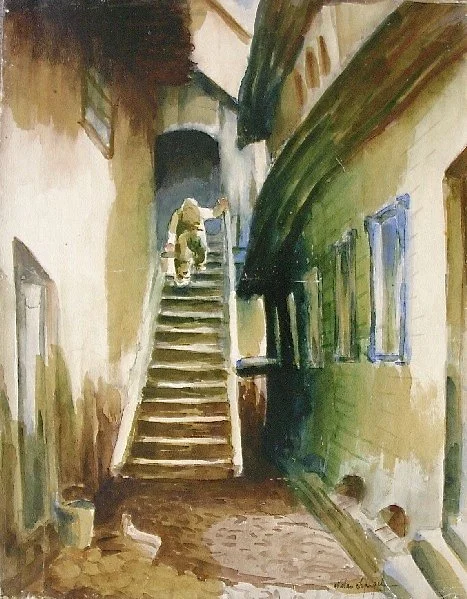Between Nothing and Infinity: Poland's Evolving Jewish Remembrance
A painting by Natan Szpigel, a well-known doctor and painter in Radomsko, murdered in Treblinka.
I remember the confusion I felt when I visited my family’s town, Radomsko, on my first trip to Poland in the fall of 2000. What was I looking for? I had no idea. I didn’t know anybody there. My relationship to the town, where my mother’s family had lived for over a hundred years, had been obscured by time, emigration, and trauma.In the Radomsko Regional Museum, located in the lovely historic town hall, I accompanied a guide past collections of pottery shards from archeological digs, displays of nineteenth-century butter churns, exhibits of roof thatching and farm implements.
There were photos of Radomsko citizens deported to Siberia under Russian rule, infantry helmets from the First World War, and gruesome pictures of Polish partisans from the town, standing in front of pits before their execution by German soldiers. Where was any mention of the town’s Jewish citizens, nearly 55% of the town before World War II, almost all of whom perished under the German occupation?
Our guide finally paused in front of a glass case which contained artifacts from the Jewish community of Radomsko: a set of tefillin like my grandfather Louis wore; a pair of silver Kiddush cups; silver candlesticks; and two small oil paintings by a noted local painter. The paintings evoked the ambience of the town’s prewar Jewish life: well-worn wooden benches in an intimate little prayer house; a water carrier lugging his bucket up a crooked staircase. But I was disappointed. Just one glass case? A few years later, in Warsaw, I mentioned this lonely glass case to a friend, Kostek Gebert, a prominent Polish journalist and a member of Warsaw’s Jewish community. “Believe me,” he said, “ten years ago there was nothing in Radomsko. What you saw was not just ‘a little glass case.’”
He paused.
“Please. You must understand, there’s infinity between nothing and a little glass case.”
It was a great insight. After all, any mention of the fate of Poland’s Jews was taboo under the Communist regime. Assembling those artifacts for the Radomsko Regional Museum was a one brave step on the path to freeing up the discussion about Poland’s Jewish history. Over subsequent visits, at the instigation of both the town’s Polish residents and Jewish visitors, I was fortunate to witness a number of other efforts: the Yizkor (memorial book) of the town’s Jewish population translated into Polish and published in the town’s newspaper; stones and plaques identifying places of Jewish celebration and worship; recognition for a Radomsko elder—Marian Bereska—who with his mother rescued five Radomsko Jews (including my cousin).
This week, when the core exhibition of Warsaw’s eagerly anticipated Museum of the History of Polish Jews—a work in progress for almost twenty years—opened to the public, I thought of that one glass case in my family’s home town. It wasn’t nothing. It was a beginning, even a considerable accomplishment during the Communist era.
The article in the American online mag that heralded the museum’s opening was headlined: “A Museum That Won’t Let Poland Forget.” But that’s not really accurate. The new museum’s exhibitions allow all of us to remember. They allow us to contemplate the long era of Jewish history in Poland—the disastrous end put in the context of nearly a thousand years of creative, intellectual, and spiritual flourishing.
Now, in democratic Poland, the long intertwined history of Polish Catholics and Polish Jews is finally on display for all of us to remember together.
Let the conversation continue.
